Photography courtesy of Lowell Washburn, all rights reserved.
I wasn’t until I was in high school that I saw my first peregrine falcons. Well, sort of. The birds were actually a pair of mounted specimens perched atop a fake, papier-Mache cliff ledge behind the glass window of a wildlife diorama in St. Paul, Minnesota’s Bell Museum. Although the work was flawless, the taxidermied birds lacked spirit – no more real peregrines than birds painted on canvas.
But according to the exhibit’s curator, those feathered effigies were as close as I would ever come to seeing an honest-to-goodness wild peregrine; quickly adding that the declining species was at the brink and was likely headed for soon extinction. A casualty of the indiscriminate, post-World War II use of DDT pesticides, peregrine populations – along with bald eagles, osprey, and others –were going down in flames. The predicted horrors of Rachael Carson’s “Silent Spring” were coming to pass. In Iowa, Minnesota, and Wisconsin peregrines had already mostly disappeared from the historic cliff ledge eyries of the Upper Mississippi River. The species had completely vanished from its traditional strongholds in the eastern U.S.
The curator’s words cut like a knife. For as long as I could remember, I had been in love with the Birds of Prey – those wild and courageous winged hunters of the open skies. Of all the hawks, falcons, and eagles I had to choose from; the noble peregrine had quickly become my favorite. After viewing the original, 1958 airing of Walt Disney’s “Rusty and the Falcon”, I longed to feel the thrill of hunting in the company of wild falcons. For a nine-year-old boy, it was a lofty though seemingly impossible dream.
In the years that followed, I read everything I could get my hands on regarding America’s legendary ‘Duck Hawk’. The sources included encyclopedias, school library books, notes by John James Audubon, and popularized magazine articles. I learned that the peregrine was credited with being the planet’s fastest living creature. The preferred choice of nomadic desert sheiks and European royalty, peregrines had stood at the very pinnacle of traditional falconry – the pastime of pursuing wild game with trained raptors – for at least the past four thousand years, give or take. As I gazed into the diorama, the notion that the species would soon breathe its last seemed devastating.
Fortunately for all of us, the museum curator was sorely mistaken. In 1972, the use of DDT was forever banned. Equally significant was the fact that a handful of falconers were learning how to successfully produce falcon chicks from birds taken from the wild years before. Although something of a monumental long shot, the idea of restoring vanished peregrine populations by releasing captive bred youngsters was a concept worth trying. Amazingly, some of the released chicks survived to adulthood and the peregrine’s remarkable road to recovery was underway.
During the 1980s, I enjoyed the unique opportunity of spending five consecutive years working with Iowa’s peregrine falcon recovery program. The project’s success hinged on a dedicated team effort involving Iowa falconers, raptor propagators, professional biologists, and a gung-ho cadre of private sector conservation enthusiasts. The effort included both industrial and cliff ledge release sites resulting in the procurement, release and intensive monitoring of 102 captive produced, fledgling falcons. Survivors of those releases established successful nesting territories in Iowa, Minnesota, Wisconsin and elsewhere. Most importantly, falcons released in Iowa began to successfully reoccupy the historic cliff ledge nest sites of the Upper Mississippi. During the past three decades, peregrine numbers have continued to soar. Today, the number of peregrine falcons currently nesting in Iowa exceeds historic levels – an amazing conservation accomplishment.
No longer considered to be threatened or endangered, the peregrine falcon has been completely delisted by the U.S. Fish & Wildlife Service. For the first time since the species’ tragic demise and subsequent recovery, the Fish & Wildlife Service is allowing a limited take of first year [passage] peregrines for use in falconry. As an Iowa falconer, I’ve had the privilege of training and flying fourteen peregrine falcons during the past 34 years. Each of those falcons were the offspring of captive breeding projects. And although I loved them all, I still longed to capture and train a migrating wild peregrine.
Renewed hope – or at least a glimmer of it –occurred in 2018 when Iowa falconers were offered a total of five peregrine capture permits to be issued through a lottery drawing. I applied, of course. But demand was high, and I was eliminated in the draw.
In 2019, I applied again but was drawn out for a second time. I learned that Minnesota was allowing nonresidents to compete for their five permits. I applied but, once again, failed in the draw. But when one of the Minnesota permit holders unexpectedly turned their license back, the DNR tossed everyone’s application back in the hat for a redraw. When they gave the squirrel cage a couple of cranks, my name came to the top. I couldn’t believe it. I had won a chance to attempt trapping a wild peregrine! Needless to say, I was jacked out of my skull. Hastily throwing together a box of hoods, trapping permit, and other hawking paraphernalia; I called my falconry friends in Minnesota and headed north.
Minnesota’s Lake Superior region is one of North America’s best locations for observing large numbers of migrating birds of prey. Reluctant to cross the inland ocean’s watery expanse, tens of thousands of southbound raptors annually funnel down Superior’s 350-mile long northern coastline. But although peregrines may be growing in abundance, trapping one is no slam dunk. In spite of the stellar location, I was unsuccessful in trapping, or even seeing, a migrating peregrine during my first trip to Superior. Ditto for my second foray.
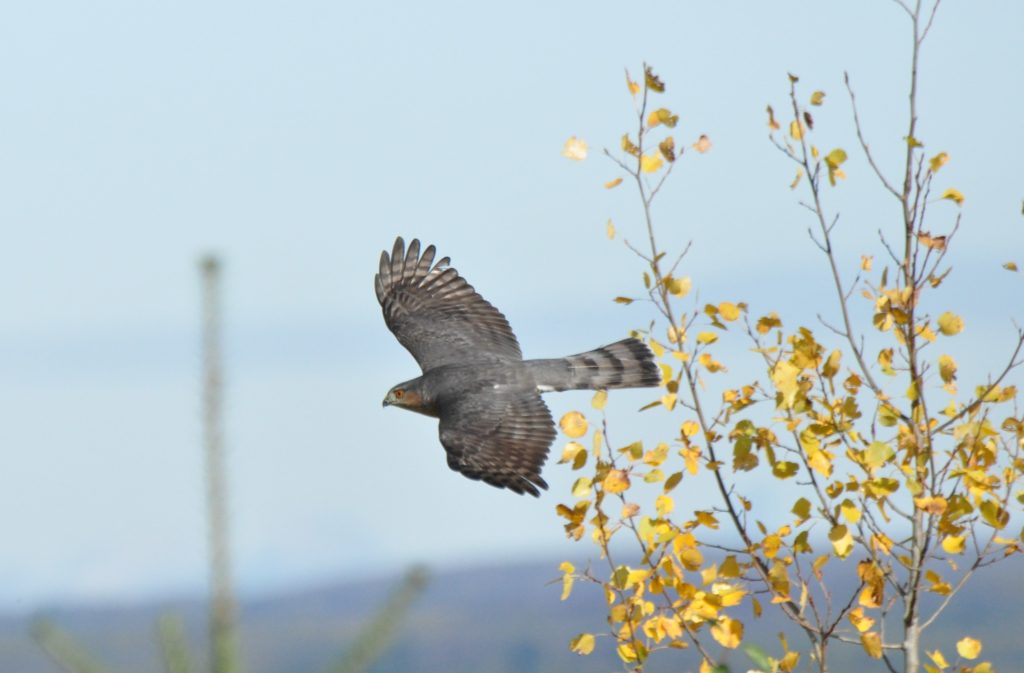
Early this week, I headed north again for what would likely be the season’s final attempt. The annual bio-clock was running out. With the bulk of this year’s peregrine migration already south of Duluth, I knew my back was against the wall. But regardless of whether or not any falcons would be sighted, I would at least be in good company; spending my adventure with Minnesota falconer Jack Vooge who has been trapping the area since 1978; renowned birding authority, Gary Swanson; and Ben Ohlander, a published authority on northern goshawks.
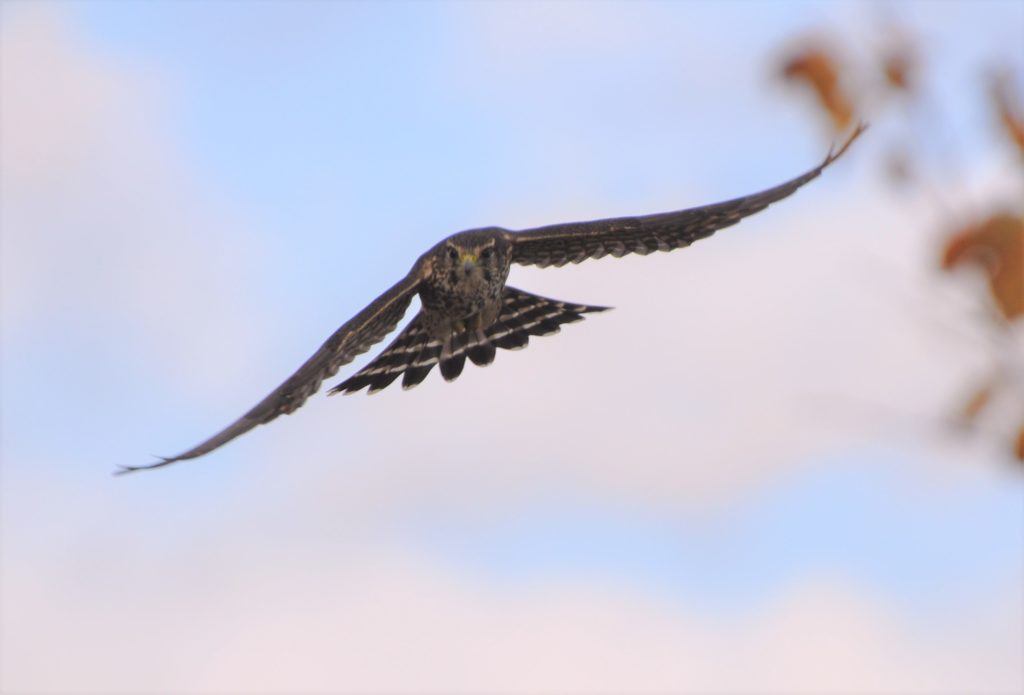
Arriving atop a ridgeline near the lakeshore, we quickly erected a set of four large mist nets. Temperatures were crisp, the skies clear, and a rising westerly breeze was scheduled to swing more to the north. All in all, a near perfect day for seeing and trapping hawks. Safely located behind the corral of netting was a harnessed pigeon. When lifted by an attached pulley line, the fluttering bird would become the live bait that would hopefully lure a passing falcon to our invisible barrier. The ruse becomes successful when passing hawks mistake the pigeon for an easy meal. When a raptor presses the attack and strikes the net, it becomes entangled in the mesh. The pigeon remains unharmed, ready to tempt the next passing hawk.
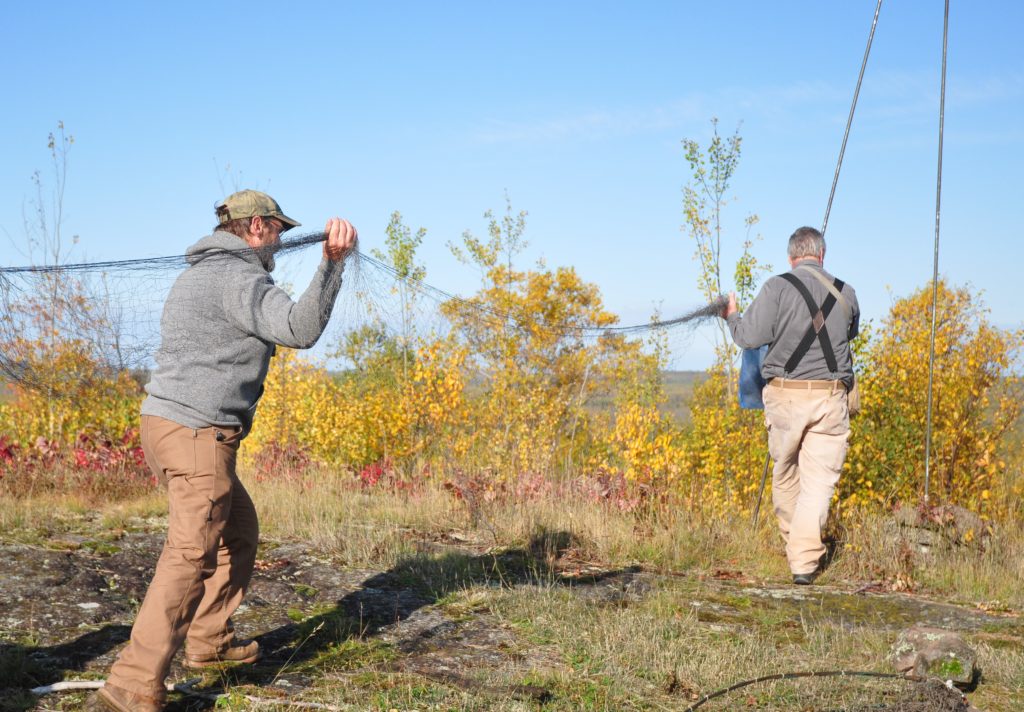
Crawling into the cozy confinement of our trapping blinds, we began scanning the skies. As the morning progressed, the anticipated stream of southbound raptors began to appear. For the first couple of hours, the flight was dominated by a near never ending procession of tiny sharp-shinned hawks. As the migration continued, we began to observe a healthy infusion of merlins, kestrels, red-tails, a single goshawk and multiple eagles. Although the aerial bird show was exciting, the species we most hoped to see failed to appear. That is until late afternoon when I suddenly spotted what could only be an honest-to-goodness, wild peregrine falcon flying down the ridgeline. Spotting our tethered pigeon, the bird turned, launched an attack, and then crashed the net with such gusto that the impact bent one of the 8-foot-tall metal support poles.
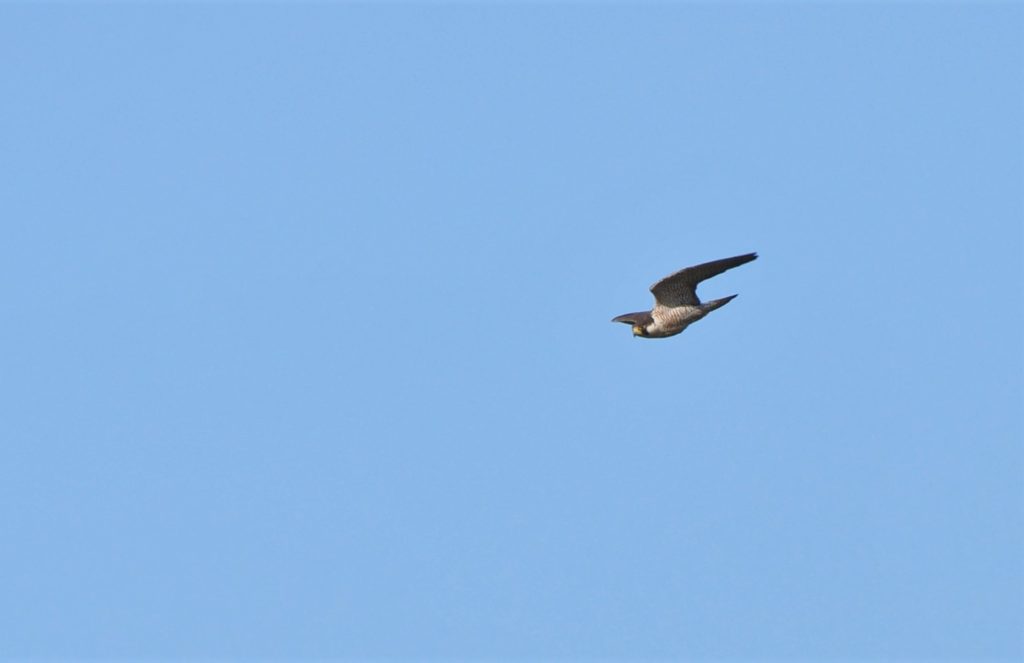
Stunningly beautiful, the falcon turned out to be a white-breasted, tundra female – the very first peregrine I had encountered in three trips to Superior. The bird was an adult. And since only first year peregrines are legal for take, we had to let her go. Nevertheless, it was still a thrill to see and handle such a magnificent bird.
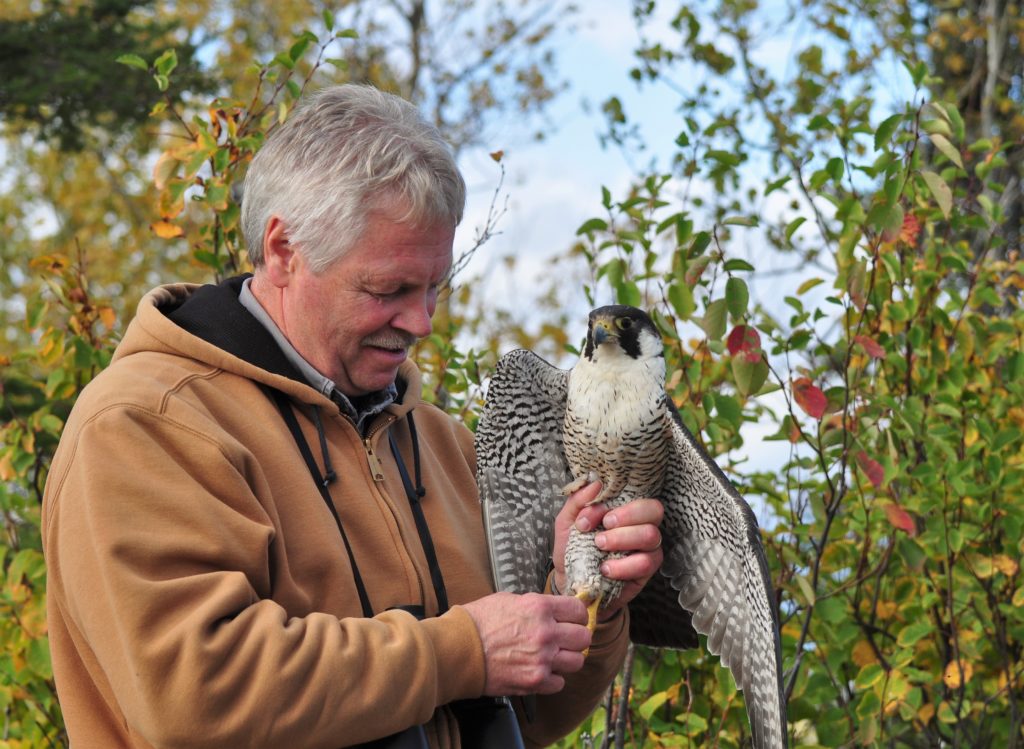
As the afternoon wore on, a sudden squall blew in from the southwest. But although an incredible number of hawks were riding the squall line, the much anticipated first year peregrine didn’t show. The day finally ended, and we began packing to leave. Although there was currently no bird anywhere in sight, Jack decided to give the pigeon line one last pull. And that’s when it happened. Within seconds of twitching the pigeon, a big passage female peregrine came smoking in from who knows where. Crashing the net at warp speed, the falcon was instantly entangled. Robust and feather perfect, the extracted falcon weighed in at 30 ounces; an admirable weight for a first-year migrant.
And so it ended. At one second, I was once again going home empty handed. A minute longer, and I was pulling a legal, first year peregrine falcon from the net. For me, the opportunity to capture a wild peregrine for use in falconry was a lifetime event – the culmination of a boyhood dream that I’d been harboring for more than 60 years. Surrounded by wild hawks in wild country, it was an emotional moment. It was Jack Vooge who finally broke the silence.

“What a surprise,” he exclaimed. “The way this all happened is incredible. It’s just like it was meant to be.” We agreed.

 Tom Cope
Tom Cope Sue Wilkinson
Sue Wilkinson Susan Judkins Josten
Susan Judkins Josten Rudi Roeslein
Rudi Roeslein Elyssa McFarland
Elyssa McFarland Mark Langgin
Mark Langgin Adam Janke
Adam Janke Joe Henry
Joe Henry Kristin Ashenbrenner
Kristin Ashenbrenner Joe Wilkinson
Joe Wilkinson Dr. Tammy Mildenstein
Dr. Tammy Mildenstein Sean McMahon
Sean McMahon